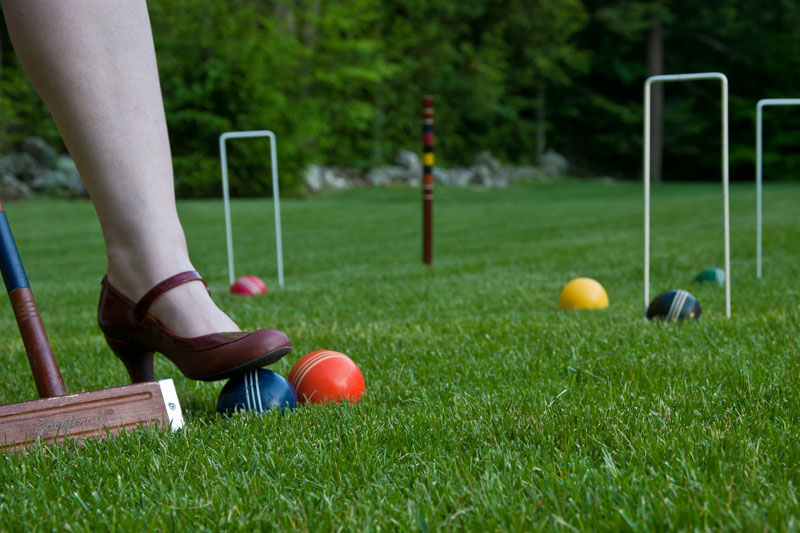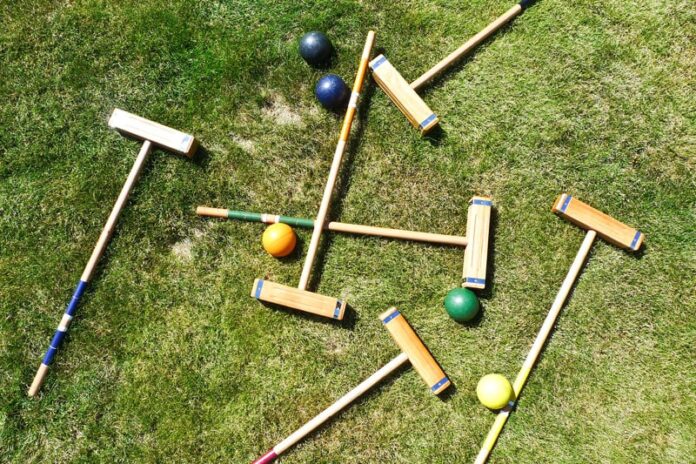Croquet is a classic outdoor game from the mid-19th century. It has become a beloved pastime worldwide. It requires strategy, precision, and some friendly competition. So, it’s a favorite at parks and backyard gatherings. Players use a mallet to hit their balls through hoops (or wickets) on the lawn. in this article, we will cover basic croquet rules along with equipment, gameplay, and strategies to master this classic outdoor game
Croquet began in Europe. Now, it is played worldwide. Variants like association, golf, and garden croquet add unique twists to the traditional rules. To enjoy croquet at any level, you must know the basic rules. This includes both casual backyard games and competitive play.
Equipment Needed
To play croquet, you’ll need the following essential equipment:
- Croquet Mallet: Each player uses a mallet to strike their ball. Mallets vary in size and weight, allowing for a more personalized feel. Choosing the right mallet can improve accuracy and control.
- Balls: Croquet uses hard, durable balls, typically made of plastic or wood. Each player is assigned a ball, usually in distinct colors for easy identification.
- Hoops (Wickets): Hoops are metal arches placed on the lawn in a specific arrangement. The goal is to hit your ball through these hoops in the correct order to score points.
- Stakes (Pegs): At either end of the croquet court, you’ll find two stakes. The final objective of the game is to hit the stake after passing through all the hoops.

Setting Up the Game
To set up a croquet game, prepare the court. Then, ensure the hoops and stakes are in the right places. Here’s how to do it:
- Court Dimensions: A standard croquet court is 35 by 28 yards. It can be adjusted based on the available space. For casual play, any flat, open lawn will work as long as it’s large enough to fit the necessary equipment.
- Hoop Placement: Arrange six hoops in a double-diamond pattern. Place two hoops near each stake and two in the center of the court. The hoops should be spaced so players can navigate their balls through each one in order.
- Stake Placement: Position two stakes on either end of the court. These stakes are the beginning and ending points of the game. Players start near one stake and aim to pass through all the hoops before hitting the final stake.
- Ball Assignment: Each player or team selects a ball, usually color-coded (e.g., red, blue, black, or yellow). The color of your ball will determine your turn order.
Objective of Croquet
The goal of croquet is to be the first to hit the final stake. To do this, you must navigate your ball through all the hoops in the correct order. Players take turns using the mallet to strike their balls. They aim to pass through each hoop in the proper order. After passing through the hoops, the game ends with a shot at the final stake.
Key objectives during the game include:
- Hit the Hoops in Order: Players must hit their ball through the hoops in a specific order and direction.
- Control the Ball: You must control the ball. Position it close to the next hoop. This increases your chances of making shots.
- Hit the Final Stake: Players aim to hit the final stake after passing through all the hoops. The first player to hit the stake wins the game.
Basic Gameplay
Croquet is turn-based, but it also allows for strategic interactions between players. Here’s how a typical round plays out:
- Turn Order and Striking the Ball: Players take turns hitting their ball using the mallet. Each player gets one stroke per turn. They must advance their ball through the hoops in the correct order.
- Successful Shot: A player earns an extra stroke for hitting their ball through a hoop. This means they can take another shot immediately. Players can string multiple shots together if they continuously pass through hoops.
- Missed Shot: If a player misses the hoop or fails to make a useful play, their turn ends. The next player takes their shot.
- Roqueting: A unique aspect of croquet is that players can strike other players’ balls. This is known as roqueting, and when it happens, the player earns two additional strokes. The first stroke places their ball next to the struck ball. The second lets them hit both balls or reposition their own.
Scoring and Winning
In croquet, you score by getting the ball through each hoop and hitting the final stake. Here’s how points and winning are determined:
- Scoring Points: Each time a player hits their ball through a hoop in the correct order, they score a point. The game continues with players trying to score by advancing through the hoops.
- Winning the Game: The first player to pass their ball through all the hoops in order and hit the final stake wins. After a player has successfully hit the stake, the game is over.
Winning in croquet requires accurate shots and good tactics. You must also make effective use of extra strokes gained through hoops or roqueting.
Common Croquet Rules and Variations
The core principles of croquet are consistent. But there are a few popular variations. Each has its own rules and gameplay twists. Here are some of the most common versions:
- Association Croquet: This is the most formal and widely played version of croquet. It follows a strict set of rules and is typically played on a regulation-size court. Players aim to hit their ball through six hoops twice in a specific order before hitting the final stake. The game allows for complex tactics, like croquet shots and roqueting.
- Golf Croquet: In golf croquet, the game is faster-paced, with fewer complex rules. Players compete to be the first to hit their ball through each hoop, one at a time. They do not complete a series of hoops in a specific order. There is no continuation after a successful shot. So, it is a simpler and more casual version of croquet.
- Garden Croquet: This is a simpler version of croquet. It is often played in backyards or parks. The rules are flexible, and the game is more casual. The court can be smaller, and hoop placement is often adjusted to fit the space. Garden croquet is ideal for family gatherings and informal play.
Each variation adds a unique flavor to the game. It caters to different competitiveness levels and playing environments.
Penalties and Fouls
In croquet, there are specific fouls and penalties that players need to avoid. These violations of croquet rules can lead to the loss of a turn or other consequences. Here are some of the most common fouls:
- Striking the Ball Twice: A player may only hit the ball once per turn. If a mallet strikes the ball more than once in a single swing, it’s considered a foul, and the player’s turn ends.
- Touching the Ball: Players are not allowed to touch or move their ball with their hands or feet. If a ball is accidentally moved, it must be placed back in its original position, and the player’s turn is forfeited.
- Moving the Hoop: If a hoop is displaced during gameplay, it must be returned to its original position. The player responsible loses their turn.
- Out-of-Bounds: If a ball rolls out of bounds, the player must return it. Place it one mallet’s length inside the boundary line. The player’s turn then ends.
- Wrong Ball Order: If a player strikes the wrong ball or plays out of turn, they lose their turn. The ball is returned to its original position.
These penalties keep the game fair and add to its strategy. Players must be careful with each shot.
Conclusion
Croquet is a fun mix of strategy, skill, and socializing. It’s perfect for gatherings and friendly competition. By knowing the basic rules, players can enjoy the game more. This applies to both casual backyard games and formal play on a regulation court.
Understanding the objectives, croquet rules, and game variations enhances the experience. It fosters a greater appreciation for this timeless sport. Croquet has endless fun and camaraderie for beginners and experts alike.







